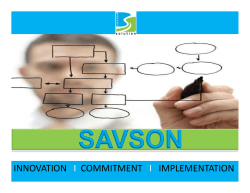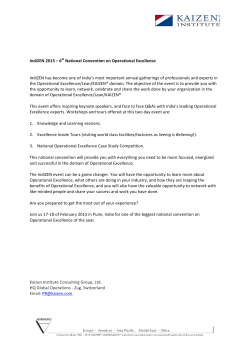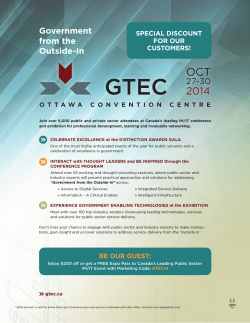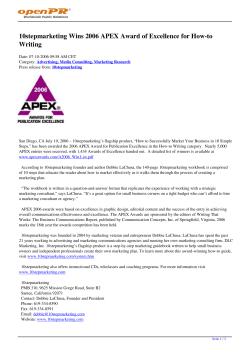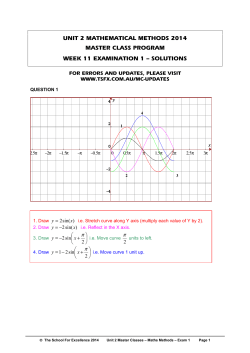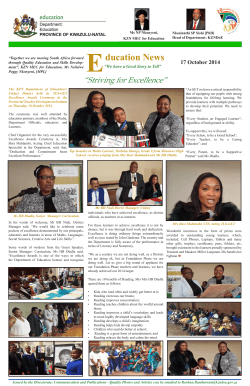
Welcome Passion for Excellence Module II of III
Welcome Passion for Excellence Module II of III Our Passion for Excellence Module I • Setting the foundation – Mission – Vision – Core Values • Hearing from our patients and families • Creating the best possible experiences for our patients and families, faculty and coworkers Module III • Managing conflict • Service recovery Module II Objectives • Define what is meant by service excellence • Assess your active listening skills • Identify the importance of teamwork and collaboration • Describe the elements of positive organizational theory as applied to our workplace • Understand the special traits and talents you bring to your work AGENDA • Introduction • Creating A Culture of Excellence – Defining Service Excellence – Building on the Service Principles • Positive Organizational Scholarship Our Passion for Excellence Shows… • In our commitment and dedication to our work • In the compassion we show to our patients and others • In working to be the “Leaders and Best” • In the service we provide Our Passion for Excellence Why focus on service excellence? • It’s the right thing to do • It’s even more important with our high volumes • It feels good to provide great service as well as great care • Because patients have a choice • It can make our jobs easier and be a more pleasant work experience From the perspective of… • Patients and families – – – – – Need for information Knowing what to expect Understanding options Being included in decisions that affect them Exceeding their expectations “Need to make the service diagnosis and offer the right treatment” From the perspective of… • Coworkers • Faculty • Students • Who else are your customers? Creating the Ideal Experience Activity: Defining Service Excellence from the “Customer’s” Perspective In your table groups: • Introduce yourself using NOD • Describe the needs/expectations of the customer group assigned to your team • Identify someone to record the needs your team has identified and a spokesperson for your group Report out Time: 15 minutes • OUR Core Values We, the staff and faculty of the Cardiovascular Center team are committed to advancing medicine and serving humanity through living and teaching our core values of: - Respect and Compassion We honor and care for one another as individuals. - Collaboration We honor the synergy of team, built on trust. - Innovation We honor individual and collective creativity. - Commitment to Excellence We honor the intrinsic desire to be “Leaders and Best.” Respect and Compassion We honor and care for one another as individuals • Greetings • Checking for identifiers • Maintaining privacy • Communicating time frames • Empowered to use service recovery when things don’t go as planned Respect and Compassion Greetings – Tips for Building Rapport • Greet People – Make eye contact and smile (be respectful of cultural differences) – Use the appropriate title, Mr., Mrs., Ms. – Introduce yourself using NOD – 10 foot/4 foot “rule” • Value People – Demonstrate respect – Pay attention to body language – Avoid making assumptions – Manage your thoughts – Be present Respect and Compassion • Ask How to Help – Use open ended questions – Ask: “How may I help you?” • Listen – Listen to the “whole” communication – Listen with empathy Take care of their need – efficiently and effectively • Closing – Ask: “Is there anything else I can help you with” Respect and Compassion Obstacles? What gets in the way for customers? Respect and Compassion What gets in the way for you? • Overwork and stress • “B” team players • Hot buttons Video Vignette Respect and Compassion Activity: Video Vignette • What behaviors did you observe when Susie greeted the patient? • What was different in the second scenario? • What else could she have done? Respect and Compassion Purpose: To develop an awareness of our emotional triggers/hot buttons Activity: Complete the assessment on page 11 of your manual Length: 5 minutes Respect and Compassion Communicating Time Frames • Anticipate the customer’s needs • Communicate time-frames and other options if we suspect the wait time is too long • Address comfort needs Respect and Compassion • Diverse patient and employee population • Stereotyping in the media and elsewhere makes it easy to make assumptions about people • These assumptions may get in the way of the platinum rule – treat others as they would want to be treated What can you say about this person? 1 3 2 4 Collaboration • We make decisions with all those • • • • affected present Communication is respectful whether oral, email or other written forms We resolve conflicts and share differing opinions We say thank you We provide feedforward Collaboration • We actively listen • We honor the multidisciplinary approach to care • We need and rely on the team • We recognize that open communication is critical for care and safety Collaboration Facts about Listening When we listen with our: Ears Eyes Heart We listen for: Content Body language Emotions Listening is: 40% Skill 60% Discipline/Focus Speaking rate Listening rate 125 wpm 500 - 750 wpm Collaboration Activity: Roleplay Demonstration • What did you observe? • How would you describe the communication and collaboration between the doctor and patient? • How could this situation have been improved? Collaboration Active Listening Skills • • • • • • • • Allow people to finish sentences without interrupting Ask clarifying questions Maintain strong eye contact when listening Remember and use people’s names Pay attention to body language Focus on what people are saying instead of thinking of what I am going to say Listen non-defensively when people are upset Notice assumptions you may be making Collaboration Paraphrasing Exercise In pairs: • Choose a speaker and a listener • Choose a controversial subject and express your views and opinions about it (2 minutes) • Your partner will paraphrase what you said with his/her own words (1 minute) • Check to see if the speaker was understood • Switch roles Collaboration Business Communication Tips • • • • • • • • • Think before you write Use spell check and read it over Do not debate issues via email Do not use email to criticize someone Only copy others are your response if it is absolutely necessary Be conscious of tone – never email when angry Humor can be tricky Using all caps is like screaming Beware of abbreviations such as BTW Collaboration • Multidisciplinary collaboration is one of the foundational ideas in the CVC • Collaboration is important for: – Patient safety – Efficiency – Better outcomes Collaboration Exercise: • Turn to page 16 in your manual. • Each block represents a well known phrase. • Try to solve as many as possible in the next 3 minutes. Innovation • Constantly seek ways to improve • Empowered to solve problems • Open minded to new approaches and feedback • Use an understanding of best practices to improve delivery of care • Strive to create the “ideal patient experience” with every interaction • Learn from mistakes to improve future outcomes Innovation • Systems and processes need to support service excellence • If there is a gap between system performance and service needs, it is everyone’s responsibility to fix it • How? – Michigan Quality System (MQS) – Plan Do Check Act (PDCA) Commitment to Excellence Take pride in our appearance Wear CVC nametags Gather ongoing and regular feedback Strive for first time quality Follow through on problems to resolution • Patients and families come first • Recognize each other for demonstrating the principles • • • • • Commitment to Excellence Positive Organizational Scholarship (POS) • University of Michigan Ross School of Business • New way of thinking – focus on creating a positive culture • Focus on what we do well • Celebrate success Commitment to Excellence From… Our job is to overcome major problems To….. Our job is to embrace and enable our highest potential Commitment to Excellence Problem Solving Abundance Problem Identification Appreciating and Valuing Cause Analysis Explaining Success Identify Problems Creating Sustainability Action Planning Designing a Destiny Commitment to Excellence • In every organization, something works well. There is always something positive to celebrate. • The questions we ask and the language we use help determine our vision of the future. • Focusing on abundance gaps, compared to deficit gaps, leads to the “heliotropic effect”. Commitment to Excellence The Heliotropic Effect Commitment to Excellence • Those who positively energize others are higher performers. • Positive energizers tend to enhance the work of others. • People who interact with or are connected to energizers also perform better. Positive Energizers Higher Performance Enhance Work of Others Commitment to Excellence Although you may not know the people in your small group very well, you can already see positive qualities or special traits in each person. Activity: Best Self Ask one person in your group to write each person’s name on a separate, blank piece of paper (one name per page) Everyone needs sticky notes Identify positive traits you see in each person (You can use the list of adjectives in your manual) Write the positive traits you have observed on sticky notes and then place it on that person’s page Give each person their sheet – this is their reflected best self p.19 Commitment to Excellence • Energy: What happens to the energy in the room when people provide this kind of feedback to one another? • Emotions: What was your own emotional reaction to receiving this feedback from others? • Connections: What is the impact on interpersonal relationships? Commitment to Excellence The Power of Storytelling Commitment to Excellence • Recognition for each other – U-Factor – You’re Super – Thank you notes – Verbal thanks – Other • Recognition by patients – Donations funded many of the amenities in the building and the gardens outside – Patients and families often want to give something to create a legacy for the future – If a patient asks, “What can I do for the CVC?”, refer them to CVC development Commitment to Excellence • “Keep your thoughts positive, because your thoughts become your words. Keep your words positive, because your words become your behavior. Keep your behavior positive, because your behavior becomes your habits. Keep your habits positive because your habits become your values. Keep your values positive, because your values become your destiny.” Mahatma Gandhi Thank you!
© Copyright 2025
